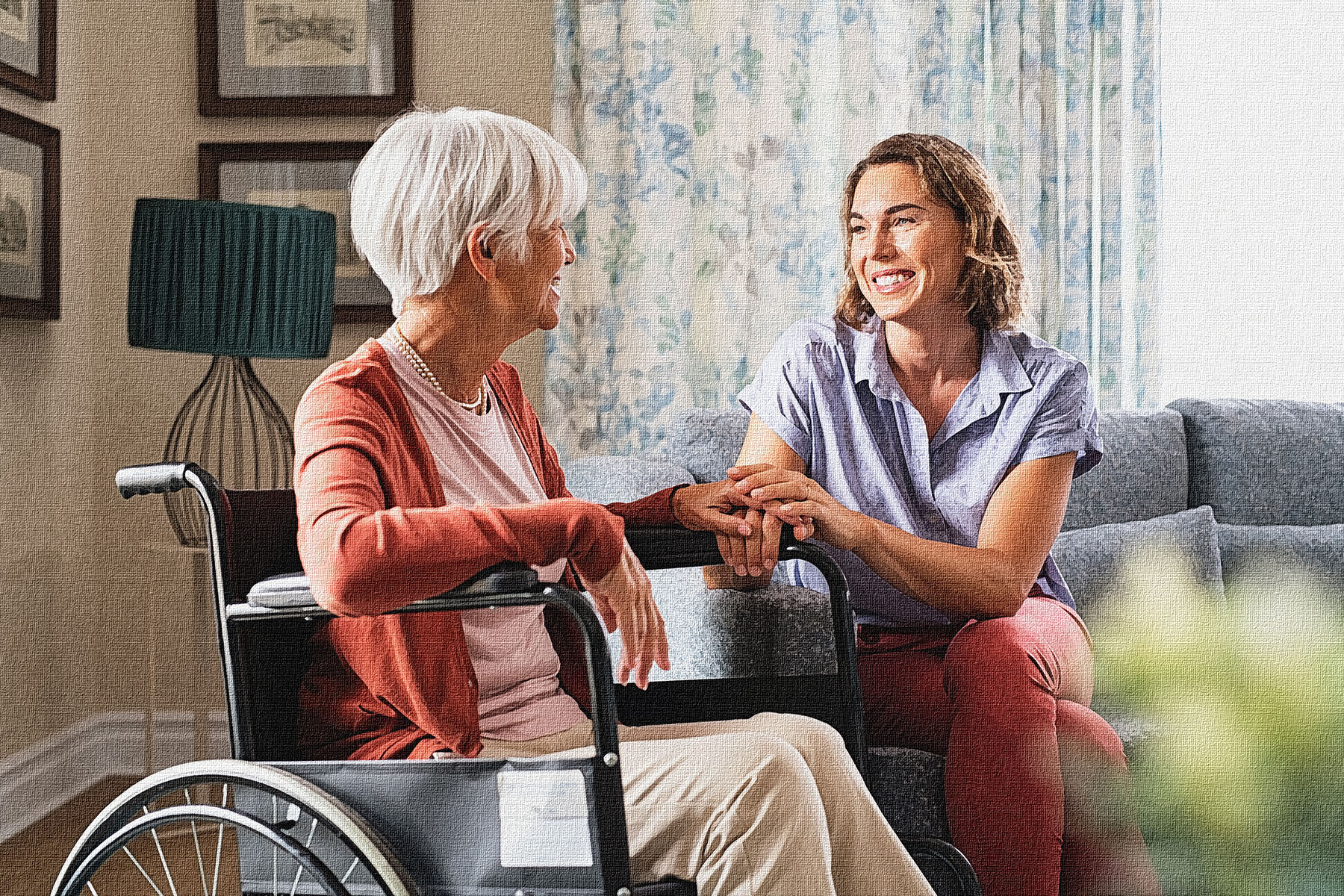Last December, I was preparing to enjoy a one-month paid sabbatical during which I planned to see my 90-year-old mother finally experience Hawaii—the last of the 50 states for her! At the same time, she began to show signs of weakness, which rapidly escalated into multiple serious health issues. In the blink of an eye, my mother went from an independent super-senior to one completely dependent on me. This health crisis thrust me squarely into the middle of one of the fastest-growing healthcare stakeholder groups—non-paid family caregivers.
As communicators, we dig deep to uncover people’s challenges and hopes as they travel along complex healthcare journeys so we can help our clients show up for them in meaningful ways. Yet, with all the resources at our disposal, we know gaps exist. Even as a primary caregiver for a parent with a chronic illness, it wasn’t until she faced a life-threatening health crisis that I realized how vast these gaps are. Suddenly, I was looking at healthcare through a different lens that offered new clarity for what I feel is my role and responsibility as a healthcare marketer.
Caregiving has reached crisis proportions in American healthcare, where cradle-to-grave care is no longer guaranteed. In 2020, 41.8 million1 Americans provided unpaid care to an adult over 50—nearly 17% of the U.S. adult population. Millions of older adults and people with disabilities could not maintain their independence without the help of unpaid caregivers, and this care would cost2 nearly $470 billion a year, if purchased.
The CDC3 classifies caregiving as an essential public health service and calls for it to be prioritized as an emerging public health issue. By 2030, an estimated 73 million people in the U.S. will be 65 years or older, and more than two-thirds of the population will likely need help with tasks at some point in their lifetime.4 While family caregiving is proven to support better health outcomes, the toll on caregivers can be devastating. An AARP report5 notes that, on average, family caregivers spend 26% of their income on caregiving activities. With less time and resources for self-care, caregivers neglect their own health and, as a result, 41% of caregivers6 report having two or more chronic diseases. The impact on caregiver health goes far beyond the physical, as the mental demands of caregiving often result in poor self-care, increased depression, psychological distress, and strained relationships, all of which can lead to caregiver burnout.
Why Marketers Must Make Caregivers a Priority
Though armed with more than two decades of healthcare knowledge, I was challenged and overwhelmed by juggling myriad providers and services on behalf of my mother—hospitals, rehab, in-home care, physical therapy, occupational therapy, visiting nurses, primary care doctors, specialists, and ambulance transport. Not to mention needing to learn how to administer more skilled care (such as IV infusions). This was an enormous task for me, an adult with high health literacy with a full-time career. In hindsight, I wondered how someone with language barriers and low health literacy who may be juggling multiple, inflexible low-income jobs would manage such a daunting challenge.
As of 2020, 62%7 of family caregivers were employed while caring for someone over 50. The Family and Medical Leave Act (FMLA) provides certain employees in all states with up to 12 weeks of unpaid leave per year to care for themselves, a sick family member, or a new child without losing their jobs or health insurance. But taking unpaid leave while also racking up healthcare costs is a luxury many of us cannot afford. While well-intentioned, this law doesn’t go far enough to address the economic realities caregivers face.
Family caregivers are racially and ethnically diverse, and language, education, and health literacy can impact caregiving quality. Most family caregivers in the U.S. identify as non-Hispanic and white, and although only 13% of the U.S. population is Black, 14%8 of caregivers are Black. In addition, 30%9 of caregivers reside in rural areas where residents typically have lower education and income levels and where there are fewer caregiver resources.
Nancy LeaMond, AARP Executive Vice President and Chief Advocacy and Engagement Officer, recently shared an urgent call to action for our industry: “The entire healthcare system—from providers to hospitals to insurers—must recognize family caregivers’ critical role and understand that teaming up with them can improve health outcomes and quality of life for both patients and family caregivers.”10
As healthcare communicators, we prioritize patients, as we should. But it’s clear that caregivers must also be a top priority based on their significant role in health outcomes. Healthcare brands must have intentional programs to communicate information to caregivers effectively, especially for those with health literacy, education, or language barriers. Effective communication not only benefits caregivers, but it also supports patient outcomes and fosters a more comprehensive and compassionate healthcare ecosystem.
4 Steps to Better Serve Caregivers
To that end, here are four steps brands can take to better serve this essential healthcare community.
1. Craft Authentic Communications
Identify and address barriers: Qualitative and quantitative research tools are critical to gain an understanding of the challenges diverse caregiver communities face. These insights can then be used to create messaging, information, and resources that help lighten the caregiver load. Content can educate caregivers on managing specific conditions, offer updates on new treatments or therapies, and provide guidance on navigating the healthcare system.
Lead with humanity: Share inspiring stories of strength, determination, and fortitude through caregivers who are balancing the demands placed on them.
Reflect diverse journeys: Caregiving is universally challenging, but the experience looks different for each caregiver. Tap into the lived experiences of individuals across the spectrum of race, culture, and economic status to create messaging that will resonate.
Be consistent: Message through relatable storytelling and representative imagery all year—not just during Caregiver Awareness Month.
Leverage data for effective targeting: Data-driven targeting strategies reveal media usage behaviors that help communicators identify platforms and pathways to meet caregivers where they are.
2. Create Intentional Communications Channels
Ease the HCP burden: Most healthcare providers recognize caregivers’ value to ensuring quality patient outcomes. Caregivers are an information resource as they observe the patient on a daily basis and can often pick up on easily missed health changes. Yet, physicians find that establishing communication with caregivers can be challenging. An AARP survey11 revealed that 39% of HCPs felt interacting with caregivers was too time consuming. It’s important for caregivers to feel empowered as advocates and to feel seen and respected by HCPs. Providing caregiver-targeted tools and resources to healthcare providers is a win-win.
Deliver on multiple platforms: Make tools and resources accessible to caregivers online, but don’t ignore other channels. Caregivers in rural areas might be challenged by limited internet access, so leveraging grassroots channels—libraries, churches, health clinics—may be a better way to engage.
Build community: Create online and in-person forums where caregivers can interact with others who are experiencing similar challenges to find support. Healthcare brands can also establish informational helplines or sponsor regular check-ins from dedicated care coordinators. Beyond the practical challenges of caregiving, it exacts an emotional toll. Supporting caregiver mental health is important to the well-being of both caregivers and patients.
3. Leverage Technology to Support Caregivers
Innovate with caregivers in mind: Realistically push the boundaries to better meet caregivers where they are in their journey. Identify and recommend any white space opportunities to R&D teams where connected technology can help improve patient outcomes and the caregiver experience. Some of the simplest tech can have the greatest impact:
- Room monitors or cameras allow for better sleeping and give caregivers the freedom to go out and run errands while still being connected to the patient.
- Smart devices can detect when there’s been a fall, changes in vital signs, or when medications have been taken to reduce the risk of medication errors or treatment nonadherence.
- Apps, or diaries for those who may not have reliable internet access, track changes in health or care patterns to better guide the caregiver to advocate for additional support. This information also helps in discussions with a medical professional about significant changes in the patient’s health.
- Medical portals streamline the process for patients/caregivers to request appointments, prescription refills, or referrals.
4. Build Influential Support Networks
Be open to new thinking: Consider engaging people who are skilled at innovating within the highly regulated healthcare space. New perspectives are critical to developing communications tools/devices that inform how, when, and where you are engaging caregivers and other audiences.
Mine for personal experiences: With such a large and ever-growing caregiver community, your internal teams may be a treasure trove of information. Look and listen to those who speak from their own experiences, for that’s where the richness lies.
When healthcare brands actively engage the vast caregiver community effectively, it fosters trust and loyalty that results in lasting relationships. As healthcare marketers, we have an opportunity and obligation to meet the caregiver crisis head-on with empathy, insights, and action. By leading with authenticity, involving people who speak from their own experiences, and engaging partners who offer new thinking about communications tools and devices, we can transform how, when, and where we engage caregivers.
References:
1. https://www.aplaceformom.com/caregiver-resources/articles/caregiver-statistics.
2. https://www.cdc.gov/aging/publications/features/supporting-caregivers.htm.
3. https://www.cdc.gov/aging/agingdata/docs/caregiver-brief-508.pdf.
4. https://www.cdc.gov/aging/publications/features/supporting-caregivers.htm.
5. https://www.aarp.org/research/topics/care/info-2016/family-caregivers-cost-survey.html.
6. https://www.cdc.gov/aging/caregiving/caregiver-brief.html.
7. https://www.cdc.gov/aging/caregiving/caregiver-brief.html.
9. https://www.aplaceformom.com/caregiver-resources/articles/caregiver-statistics.
10. https://www.aarp.org/caregiving/health/info-2019/doctor-caregiver-communication.html.










